On Saturday 14th 2017 the International Space Station ISS crossed the disk of the Moon as seen from the European Space Astronomy Center, ESAC.
ISS crosses the Moon video
 |
| ISS crosses the Moon |
ISS-Moon crossings are common, but a crossing from a specific location on Earth is not. The observer, the ISS and the Moon must be precisely aligned. The ISS is the largest man-made object in orbit, spanning the size of a football pitch. Despite its large size, it orbits the Earth at a distance of approximately 400 km, therefore looking tiny to telescope fanatics. Depending on the ISS orbit altitude and the Moon elevation over the horizon, our natural satellite is at least 30-40 times bigger than the man-made station. The geometry is so particular that the ground path where observers can see the event is only a few hundred meters wide. Therefore careful planning of the observation must be performed. The station flies at ~27000km/h therefore the transit takes is a blink of an eye to be complete.
An ESAC group composed of Michel Breitfelner, Manuel Castillo, Abel de Burgos and Miguel Perez Ayucar set up two telescopes with two Canon reflex cameras in the back of the A-building, in the freezing night. The ISS, being in Earth's shadow, cannot be spotted before the crossing, so the observation is done with a clock in hand, and basically in the blind. Everything was right at the precisely expected time. The outcome was awesome: seen a fast dark spot carrying astronauts, flying cross the Moon.





